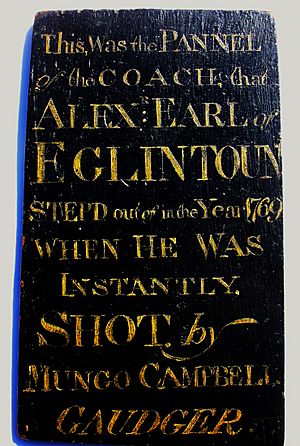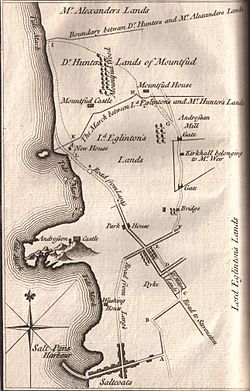Murder of Alexander Montgomerie facts for kids
Quick facts for kids
Murder of Alexander, 10th Earl of Eglinton
|
|
|---|---|

Section of the Earl of Eglinton's coach door with details of the murder
|
|
| Born |
Alexander Montgomerie
10 February 1723 Eglinton Castle
|
| Died | 25 October 1769 (aged 46) Burnhouse beach, Ardrossan
|
| Cause of death | Blood loss due to bullet wound |
| Resting place | Montgomerie family vault, Kilwinning Abbey |
| Nationality | Scottish |
| Citizenship | British |
| Education | Irvine |
| Occupation | Landowner and Scottish peer |
| Parent(s) | The 9th Earl of Eglinton and Susanna, Countess of Eglinton |
Alexander Montgomerie, 10th Earl of Eglinton (born February 10, 1723 – died October 25, 1769) was a rich Scottish noble and landowner. He was known as the Earl of Eglinton. On October 24, 1769, he was seriously hurt on a beach near his home in Ardrossan, Scotland. An excise officer, Mungo Campbell, shot him. This happened after an argument about hunting on the Earl's land and whether Mungo Campbell had the right to carry a gun there. The Earl died the next day from his injuries.
Contents
About Lord Eglinton

The 10th Earl of Eglinton, Alexander Montgomerie, was one of twenty children. He was the oldest son of the 9th Earl of Eglinton and Susanna, Countess of Eglinton. His mother was famous for her beauty.
In 1769, the Earl designed and built the village of Eaglesham in Renfrewshire. He planned the village streets to look like the letter 'A' for Alexander. He was also a leader in the Grand Lodge of Scotland, a group for Freemasons.
Lord Eglinton was very interested in new farming methods. He brought in changes that helped farming in the long run. However, these changes were not popular with many of his tenants at first.
Who was Mungo Campbell?
Mungo Campbell was born in 1712 in Ayr. His father was a local leader called a Provost. Mungo was one of twenty-four children. An uncle helped him get a good education.
Mungo joined the Scots Greys army regiment. He fought in two army campaigns. After a battle, he had a chance to become a quartermaster. But he could not get enough money for the position.
He left the army and returned to Scotland in 1745. There, he fought with Lord Loudoun's loyal Highlanders. After the Battle of Culloden, Lord Loudoun helped him. In 1746, Mungo became an excise officer. An excise officer collects taxes on certain goods. He worked in several towns, including Newmilns and Saltcoats.
The Incident
The Background Story
Alexander Bartleymore was a trusted servant of Lord Eglinton. Like many people in the area, he sometimes dealt with goods that had not paid taxes. Mungo Campbell, as an excise officer, found Bartleymore on the beach. Bartleymore had a cart with a large amount of rum. Mungo seized the rum because it was untaxed. The cart belonged to the Earl, so it was not taken. Bartleymore was held in jail. He only avoided being sent away because his master, the Earl, helped him. Bartleymore held a grudge against Mungo Campbell after this.
Another important event happened earlier. Mungo Campbell was crossing the Earl's land. He was on a road when a hare suddenly ran out. Mungo quickly shot it with his gun. The Earl heard the gunshot. Lord Eglinton was very serious about stopping poaching and protecting wildlife. So, he sent a servant to bring Mungo to him. When they met, Mungo said he was sorry. He explained that he shot the hare without thinking because it appeared so suddenly.
The Confrontation
On Tuesday, October 24, 1769, Mungo Campbell was on duty. He was walking with another officer, John Brown. They walked through land owned by Dr. Hunter. Mungo had permission to hunt there. Then, they crossed a small stream. This stream was the border between Dr. Hunter's land and Lord Eglinton's property. They walked a short distance onto the Earl's land to reach the beach. Mungo did not have permission to hunt on the Earl's land.
Lord Eglinton was traveling in his carriage. Four servants were riding horses behind him. He was told that two men, one with a gun, were seen on his land. Bartleymore, the Earl's servant, said that Mungo Campbell was one of the men. The Earl decided to check. He left his carriage and rode his horse onto the beach.
The Earl caught up with Mungo. He demanded that Mungo hand over his gun. Mungo refused, saying he would rather die. The Earl then told his servants to bring his own gun from the carriage. He said he was as good a shot as Mungo. The Earl kept walking towards Mungo. Mungo walked backward, moving away. He then tripped on a stone and fell. As the Earl quickly moved to grab Mungo's gun, Mungo fired his weapon. Lord Eglinton was seriously wounded.
Mungo threw his gun away. He tried to take the Earl's gun from a servant. But he failed. The Earl's servants then attacked Mungo. Lord Eglinton told them to stop. Mungo was tied up and taken away. He was taken to Irvine, then Ayr, Glasgow, and finally Edinburgh.
Lord Eglinton was carried back to his carriage. He was taken to Eglinton Castle. Doctors tried their best to help him. But he died ten hours later, early on Wednesday, October 25. He had made sure his affairs were in order before he passed away.
The Trial and Outcome
The legal process for Mungo Campbell's case began. There was some discussion about where the incident happened. It took place on the beach between the high and low tide marks. This area was sometimes under the control of the Lord High Admiral of Scotland. Several of the Earl's servants gave evidence as witnesses.
After the legal process, Mungo Campbell was found guilty. He was sentenced to be held in a jail in Edinburgh. On April 11, 1770, he was to be executed. His body was then to be used for medical study.
Mungo Campbell died in prison before his scheduled execution. His friends took his body and buried it at sea. He left a note that said:
Farewell, vain world, I've had enough of thee, And now am careless what thou say'st of me. Thy smiles I court not, nor thy frowns I fear, My cares are past, my heart lies easy here. What faults they find in me take care to shun, And look at home, enough is to be done.
What Happened Next
Effect on the Family
Lord Eglinton had no children. So, his brother, Archibald, became the 11th Earl of Eglinton. The door panel from the carriage, which had details of the event, was kept by the Montgomerie family for many years.
His mother, Susanna, Countess of Eglinton, was very sad. She never fully recovered from seeing her dying son brought into Eglinton Castle. She wrote that she would try to bear her sadness with as little trouble to others as possible. After the incident, she spent less time in society.
A Ghost Story
It is said that Lord Eglinton was going to marry Jean Maxwell. He had visited her home often before their planned wedding. At the exact time he was shot in Ardrossan, a servant at Jean's home saw Lord Eglinton walking up the stairs. The servant prepared a meal for him. But the Earl was nowhere to be found. Later, the sad news reached the Maxwell family.
Public Reaction
People in the towns and countryside talked about this sad event for a long time. Many of the Earl's tenants felt more sympathy for Mungo Campbell than for the Earl. They saw the Earl's death as a punishment from heaven. This was because of his life choices and his unpopular changes to his estates. He had changed old customs and interfered with old tenants. Mungo Campbell, on the other hand, was well-liked in all the places he had worked as an excise officer.
Images for kids
-
The Montfode Burn flows into Ardrossan North Bay. This was the border between the Montfode and Eglinton estates.
See also







